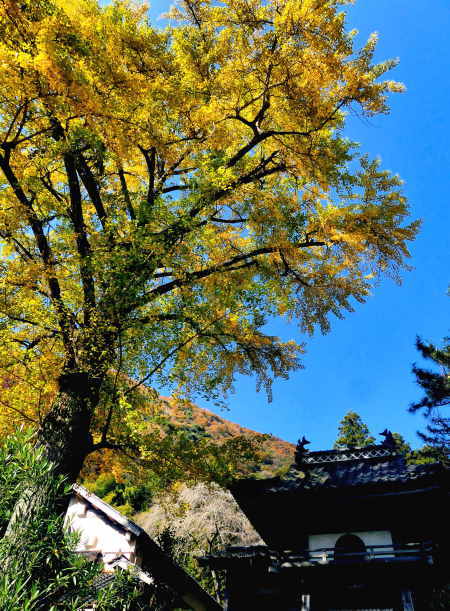Showing posts with label gingko. Show all posts
Showing posts with label gingko. Show all posts
Sunday, December 8, 2024
Chokoji Temple 10 Iwami Kannon Pilgrimage
Friday, April 14, 2023
Mountain Shrines Autumn Foliage
Labels:
gingko,
komainu,
kunisaki fall,
Shrine,
torii
Friday, December 10, 2021
Kannabiji Temple's Gingko
Kannabiji Temple's Gingko
It's that time of the year when I post some pics of this year's autumn colors. About three weeks ago Yoko had a day off that coincided with a beautiful sunny day so we headed off on a local trip to see if we could find some color. The first stop was Kannabiji Temple, a few kilometers upstream on the Gonokawa River.
All that remains now is the main hall, a large residence for the priest, a gate, and a large storehouse. I went inside the main hall many years ago and was surprised by a mural on the ceiling and the brightly-painted woodwork. I really want to go back and take a lot of photos. I've also been inside the old priest's house though he now lives in a newer house in front of the temple.
Monday, August 10, 2020
Kosenji Temple number 42 on the Kyushu Pilgrimage
Hachimanyama Kosenji Temple is at the eastern end of the Ebino Valley in the higjlands around the Kirishima Montains in Miyazaki. It is number 42 on the 108 Shingon temple pilgrimage on Kyushu.
It is a fairly modern temple founded in the early Taisho era, so is about 100 years old. I'm no expert, but it seems that the Gingko trees were a little older than that.
It has an unusual hnzon, a statue of Dainchi riding a cow, though I didn't get to see it. Also unusual for the Kyushu pilgrimage is an actual Daishi-do.
There was quite a bit of interesting statuary which I will post on later, and also one building had quite a few masks on display, severa; of which were from the Iwami Kagura tradition.
Sunday, July 19, 2020
Taisanji mountaintop temple in Tokushima
Located at about 450 meters above sea level, Taisanji is the first of the bangai temples on the Shikoku pilgrimage known commonly as Ohenro, and the first of the 36 temples on the Shikoku Fudo Myo O pilgrimage. Most pilgrims on the Ohenro don't make the steep detour up to it, as I didn't when I walked it, , but I was on my first day of the Fudo pilgrimage.
According to the legend it is a very ancient holy spot for Buddhism being established in the 6th Century. Later the monk Gyoki, who is credited with founding many of the Ohenro temples, practised austerities here, and later still Kobo Daishi came here and built a building and put a statue of Senju Kannon here. It is said he received the statue from his master when studying in China.
There was a giant, ancient Gingko tree in the grounds but the leaves had all fallen. I had passed through some fall colors on the way up the mountain but at this height it had all gone. I had become intrigued by Taisanji after reading a little about Tachikawa Ryu, a school of Shingon that espoused a type of tantric practise utilizing sexual energy, and Taisanji was one of its centers. It became outlawed and actually classed as heresy by the head authorities of Shingon so all records were destroyed or locked away.
Of course there was no sign of it anywhere I could see.
Labels:
Fudo Myojin,
gingko,
henro,
niomon,
shikoku fudo,
temple
Friday, September 19, 2014
Yasaka Shrine near Sakai, Bungo Takeda
By lunchtime of my first day walking across the Kunisaki Peninsula I was approaching the foothills and the valley I was going to follow up to the center of the peninsula. In the middle of the rice paddies in a small village east of Bungo Takeda I came across this Yasaka Shrine.
Being a branch of the famous Yasaka Shrine in Kyoto, and formerly known as Gionsha, it enshrines Susano as well as various members of his "family" Like most of the shrines I'd visited today there was a carpet of golden gingko leaves.
There was a small secondary shrine in the grounds but there was no sign so I could not find out which kami was enshrined there.
Saturday, November 29, 2008
Fall colors: Gingko trees
2 weeks ago we took a drive up into the mountains near where Shimane and Hiroshima Prefectures meet. We were heading for Hikimi Gorge to see the Fall colors as down where we lived the leaves had only just started to turn.

On the way we stopped at several shrines that I had not visited before and I was please to find Gingko trees in their full golden brilliance.
I prefer the gold of the gingko to the scarlet of the maples, especially the carpets of leaves that cover the steps and ground.
Originally from China, the gingko is often planted at shrines and temples.
Labels:
gingko
Subscribe to:
Posts (Atom)











































